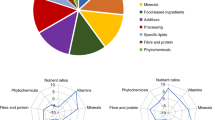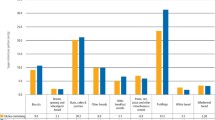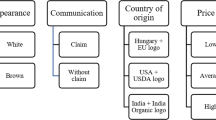Abstract
Objectives: To explore the beliefs and attitudes of Australian consumers to claims about fat made on the labels of packaged food.
Design: Content analysis of transcripts from focus group discussions.
Subjects: A total of 26 female and 10 male participants aged 20–80 y, recruited by advertisement into six focus groups, stratified by age, sex and health status.
Results: Awareness of claims about fat was high in this sample of Australians and participants admitted that they influenced their purchase decisions. The most preferred form of claim was ‘X% fat free’. Claims were considered most useful on foods that were high in fat. There was considerable scepticism about all nutrient claims, and consumers preferred to check claims about fat against the values in the nutrition information panel. Many claims were seen as advertising that could be misleading, deceptive or confusing. While claims about fat might prompt product trial, factors such as price, taste, naturalness, as well as other nutritional factors, also influenced purchase decisions. Some consumers believe low fat claims encourage over consumption of foods.
Conclusions: Changes to regulations governing nutrition claims on food labels should be made to enhance their credibility and support their role in assisting consumers to make healthier food choices.
Sponsorship: This research was supported by the Smart Foods Centre, funded by the Australian Research Council.
This is a preview of subscription content, access via your institution
Access options
Subscribe to this journal
Receive 12 print issues and online access
$259.00 per year
only $21.58 per issue
Buy this article
- Purchase on Springer Link
- Instant access to full article PDF
Prices may be subject to local taxes which are calculated during checkout
Similar content being viewed by others
References
Australia New Zealand Food Authority (1996): National Consumer Survey on Food Labelling. Canberra: ANZFA.
Garretson J & Burton S (2000): Effects of nutrition facts panel values, nutrition claims, and health claims on consumer attitudes, perceptions of disease-related risks, and trust. J. Public Pol. Marketing. 19, 213–227.
Kim S-Y, Nayga R & Capps O (2001): Food label use, self-selectivity, and diet quality. J. Consum. Affairs 35, 346–363.
Kreuter M, Brennan L, Scharff D & Lukwago S (1997): Do nutrition label readers eat healthier diets? Behavioral correlates of adults' use of food labels. Am. J. Prev. Med. 13, 277–283.
Kristal A, Levy L, Patterson R & Li S (1998): Trends in food label use with new nutrition labeling regulations. Am. J. Public Health. 88, 1212–1215.
Levy A & Fein S (1998): Consumers' ability to perform tasks using nutrition labels. J. Nutr. Ed. 30, 210–217.
Nayga R (1996): Determinants of consumers' use of nutritional information on food packages. J. Agric. Appl. Econ. 28, 303–312.
Nayga R (2000): Nutrition knowledge, gender and food label use. J. Consum. Affairs 34, 97–112.
Neuhouser M, Kristal A & Patterson R (1999): Use of food labels is associated with lower fat intakes. J. Am. Diet. Assoc. 99, 45–50, 53.
Noakes M & Crawford D (1991): The National Heart Foundation's Pick the Tick programme. Consumer awareness, attitudes and interpretation. Food Aust. 43, 262–266.
Perez-Escamilla R & Haldeman L (2002): Food label use modifies association of income and dietary quality. J. Nutr. 132, 768–772.
Reid D & Hendricks S (1994): Consumer understanding and use of fat and cholesterol information on food labels. Can. J. Public Health. 85, 334–337.
Rice P & Ezzy D (1999): Qualitative Research Methods. South Melbourne: Oxford University Press.
Smith S, Taylor J & Stephen A (2000): Use of food labels and beliefs about diet-disease relationships among university students. Public Health Nutr. 3, 175–182.
Szykman L, Bloom P & Levy A (1997): A proposed model of the use of package claims and nutrition labels. J. Public Pol. Marketing. 16, 228–241.
Williams P, Sterling E & Keynes N (2004): Food Fears: a national survey on the attitudes of Australian adults about the safety and quality of food. Asia Pacific J. Clin. Nutr. 13, 32–39.
Worsley A & Scott V (2000): Consumers' concerns about food and health in Australia and New Zealand. Asia Pacific J. Clin. Nutr. 9, 24–32.
Author information
Authors and Affiliations
Corresponding author
Additional information
Guarantor: P Williams.
Contributors: CC was responsible for data analysis and critical discussions of the analysis and manuscript. CP was responsible for data collection including organisation and leading the focus groups, and critical discussions of the analysis and manuscript. PW was responsible for design of the study, critical discussions of the analysis and preparation of the manuscript.
Rights and permissions
About this article
Cite this article
Chan, C., Patch, C. & Williams, P. Australian consumers are sceptical about but influenced by claims about fat on food labels. Eur J Clin Nutr 59, 148–151 (2005). https://doi.org/10.1038/sj.ejcn.1602038
Received:
Revised:
Accepted:
Published:
Issue Date:
DOI: https://doi.org/10.1038/sj.ejcn.1602038
Keywords
This article is cited by
-
Systematic review of the impact of nutrition claims related to fat, sugar and energy content on food choices and energy intake
BMC Public Health (2019)
-
Protocol for a Randomized Trial Assessing Consumer Evaluations of Pre-Packaged Foods that Systematically Vary by Nutrition Information and Product Attributes
BMC Nutrition (2017)
-
Perceived ‘healthiness’ of foods can influence consumers’ estimations of energy density and appropriate portion size
International Journal of Obesity (2014)
-
Do empirical studies address the objectives of the nutrition labeling and education act: a review and synthesis relevant for marketing academicians
International Review on Public and Nonprofit Marketing (2008)



